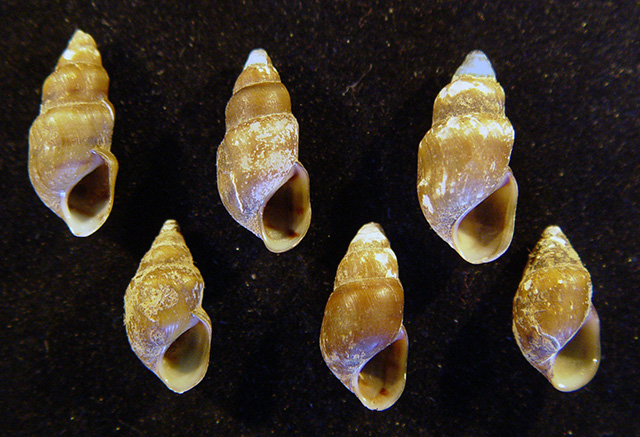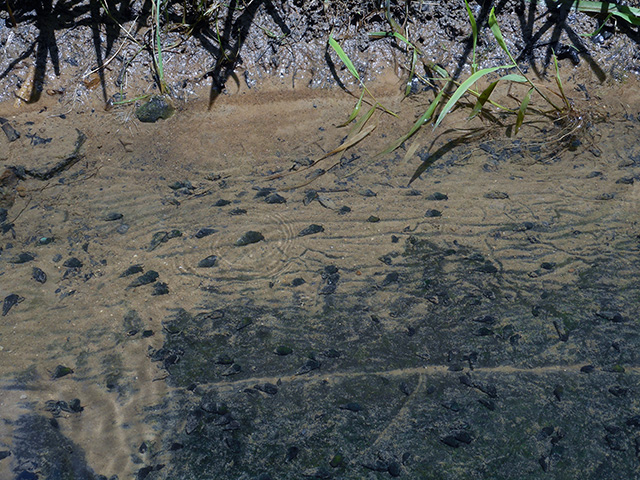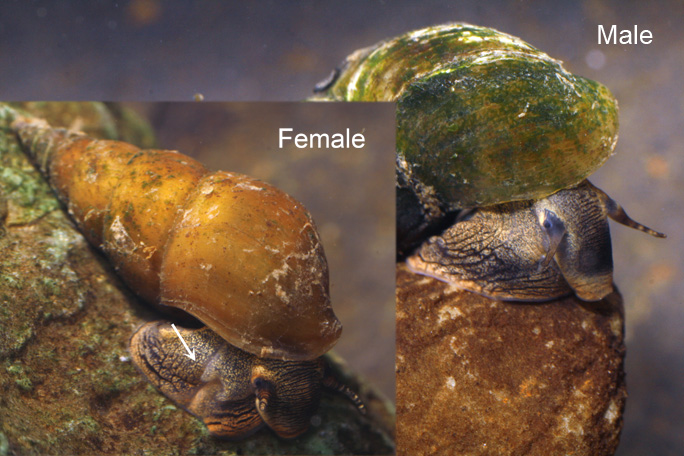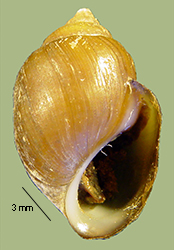Lithasia obovata
> Habitat & Distribution
Populations of P. semicarinata bearing the obovata shell morphology reach locally high densities in the main Ohio River and in larger tributaries of the Ohio such as the Kentucky, Green, and Wabash Rivers. They seem to require a rocky substrate, however, and hence are apparently excluded from impoundments, pools, and all of the (rather extensive) river stretches bearing softer bottoms throughout this region.
Populations inhabiting creeks and smaller rivers from southern Indiana and southern Ohio through Kentucky to the Cumberland drainage of Tennessee bear more slender shells and are here referred to as Pleurocera semicarinata semicarinata (Say 1829). Populations inhabiting more northern latitudes tend to bear shells with a lower spire, and are here referred to the subspecies P. semicarinata livescens (Menke, 1830). The FWGNA incidence rank calculated for all three subspecies together, across a range extending from Vermont to Wisconsin and Tennessee into Ontario, is I-5.
> Ecology & Life History
The life history studies of Dazo (1965), Mancini (1978) and Payne (1979), although focused on populations bearing the shell forms livescens and semicarinata ss in smaller streams, must surely find some application to populations bearing the obovata shell form in the larger rivers. This would lead one to hypothesize that obovata demonstrates life cycle Hi of Dillon (2000: 156 - 162), requiring two years to mature, with iteroparous reproduction thereafter. Previous bioenergetic studies might also lead one to expect obovata populations to be S-adapted, in the sense of Dillon (2000: 126 - 135). See under the typical P. semicarinata semicarinata for more.
Grazing by populations of pleurocerids can have a significant effect on energy flow in small streams (Dillon 2000: 86 - 91, see also Dillon & Davis 1991). Dazo reported that his Michigan populations of P. semicarinata livescens fed on "red and green algae, desmids and diatoms." He also reported significant rates of trematode parasitism, with azygiids, allocreads, and aspidogastrids "heavily parasitizing the liver, gonad, alimentary tract and other organs."
> Taxonomy & Systematics
"Melania" obovata is among the oldest of the North American pleurocerid taxa, described by Say (1829) from "Kentucky River" and "also at the Falls of The Ohio." The specific nomen was split out to a subgenus (later genus) "Lithasia" by Haldeman (1840), where it remained through the 19th and 20th centuries. The striking variation in shell morphology demonstrated by populations of Lithasia obovata in the Green River was the first question reviewed by Calvin Goodrich (1934) in his influential eight-part "Studies of the Gastropod Family Pleuroceridae" series. Goodrich reported a smooth intergradation in shell form down the length of the river, from slender, gracile and "goniobasoid" at the headwaters to robust and heavily-shouldered in the big river, attempting to divide the variation into eight subspecific nomina, failing.
Minton & Lydeard (2003) surveyed CO1 sequence variation across the entire North American genus Lithasia, including 8 species and 30 populations. Their results strongly suggested that two individual L. obovata sampled from the Green River are "not a Lithasia species."
Dillon's (2014) survey of gene frequencies at 11 allozyme-encoding loci demonstrated that the obovata morphology is a local shell form of the taxon we now call Pleurocera semicarinata, apparently the result of ecophenotyic plasticity, perhaps a response to the increased incidence of crushing predation in the larger rivers. We prefer to allocate all the more slender or slightly-shouldered forms (examples figured below) to the typical Pleurocera semicarianta semicarinata, reserving the obovata nomen for the most robust shell forms such as that figured above. More information about this surprising discovery is available from my essay of 11July14, link below.The karyotype of P. semicarinata livescens sampled from Dazo's (1965) Toma Road Bridge site is 2N = 36 (Dillon 1991). Given the conservative nature of chromosomal evolution in the Pleuroceridae, there is no reason to expect that the karyotypes of typical P. semicarinata semicarinata or P. semicarinata obovata would be any different.
> Maps and Supplementary Resources
- Distribution of the three subspecies in the drainage of The Ohio (2019)
- Pleurocera semicarinata semicarinata from West Fork Drakes Creek in Simpson County, Kentucky, demonstrating a range of chunky and shouldered shell morphology. Goodrich (1934) called Pleurocera bearing shells of these forms "Lithasia obovata undosa," consanguinea, sordida, and so forth. Largest shell is 20.3 mm sl, remainder to scale.

- Pleurocera semicarinata in Harrison Creek, Kentucky.
 Click for high-resolution image.
Click for high-resolution image.
- Photomontage comparing male and female P. semicarinata, highlighting the egglaying groove (white arrow). Courtesy of T. Travis Brown.

> Essays
- Taxonomic controversy has surrounded the generic nomina Pleurocera, Goniobasis, and Elimia for many years. The best entry into the subject would be my essay of 23Mar11, entitled Goodbye Goniobasis, Farewell Elimia. Links are available from that essay to older resources.
- The concept of the subspecies, as that term is applied in the FWGNA Project, was elaborated in a pair of companion essays I posted in early 2014, "What is a Subspecies?" and "What Subspecies Are Not."
- On 11July14 I posted an essay elaborating the results of my (2014) paper on cryptic phenotypic plasticity in P. semicarinata, entitled "Elimia livescens and Lithasia obovata are Pleurocera semicarinata." That essay also includes a couple additional figures of extreme shell morphologies.
- The conspecific relationship between populations of P. semicarinata bearing shells of the typical form and heavily-shelled populations of the subspecies obovata was confirmed by the phylogenomic study of Whelan et al (2022). See my essay of 23Sept25, Anchored hybrid enrichment, Pleurocerid evolution, and the obovata confirmation.
> References
Dazo, B. C. (1965) The morphology and natural history of Pleurocera acuta and Goniobasis livescens (Gastropoda: Cerithiacea: Pleuroceridae). Malacologia 3: 1 - 80.
Dillon, R. T. Jr. (1989) Karyotypic evolution in pleurocerid snails: I. Genomic DNA estimated byflow cytometry. Malacologia, 31: 197-203.
Dillon, R. T. Jr. (1991) Karyotypic evolution in pleurocerid snails: II. Pleurocera, Goniobasis, and Juga. Malacologia 33: 339-344. Dillon, R. T. Jr. (2000) The Ecology of Freshwater Molluscs. Cambridge, Cambridge University Press. 509 pp.
Dillon, R. T. Jr. (2011) Robust shell phenotype is a local response to stream size in the genus Pleurocera (Rafinesque, 1818). Malacologia 53: 265-277. [pdf]
Dillon, R. T. Jr. (2014) Cryptic phenotypic plasticity in populations of the North American freshwater gastropod, Pleurocera semicarinata. Zool. Stud. 53:31. [pdf]
Dillon, R. T. Jr., & K. B. Davis (1991) The diatoms ingested by freshwater snails: temporal, spatial, and interspecific variation. Hydrobiologia 210: 233-242. [pdf]
Dunithan, A., S. Jacquemin & M. Pyron (2012) Morphology of Elimia livescens (Mollusca: Pleuroceridae) in Indiana, USA, covaries with environmental variation. Am. Malac. Bull. 30: 127 - 133.
Goodrich, C. (1934) Studies of the gastropod family Pleuroceridae I. Occas. Pprs. Mus. Zool. Univ. Mich. 286:1 - 17.
Goodrich, C. (1940) The Pleuroceridae of the Ohio River drainage system. Occas. Pprs. Mus. Zool. Univ. Mich., 417: 1-21.
Goodrich, C. & H. van der Schalie (1944) A revision of the Mollusca of Indiana. Am. Midl. Natur. 32: 257 - 326.
Jokinen, E.H. (1992) The Freshwater Snails (Mollusca: Gastropoda) of New York State. NY State Mus Bull 482, Albany, New York.
Mancini, E. R. (1978) The biology of Goniobasis semicarinata (Say) [Gastropoda: Pleuroceridae] in the Mosquito Creek drainage system, Southern Indiana. Ph.D. Dissertation, University of Louisville. 93 pp.
Minton, R. L. & C. Lydeard (2003) Phylogeny, taxonomy, genetics, and global heritage ranks of an imperiled, freshwater snail genus Lithasia (Pleuroceridae) Molecular Ecology 12: 75-87.
Payne, B. (1979) Bioenergetic budgeting of carbon and nitrogen in the life histories of three lake populations of the prosobranch snail Goniobasis livescens. PhD dissertation, Syracuse University.
Smith, D.G. (1980) Goniobasis virginica Gastropoda Pleuroceridae in the Connecticut River USA. Nautilus 94:50-54.
Whelan, N.V, P.D. Johnson, J.T. Garner, N. Garrison & E. Strong (2022) Prodigious polyphyly in Pleuroceridae (Gastropoda: Cerithioidea). Bulletin of the Society of Systematic Biologists 1(2). https;//doi.org/10.18061/bssb.viis.8419








